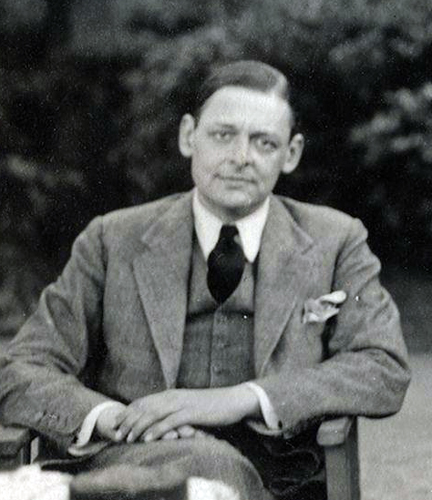63 T. S. Eliot (1888 – 1965)
Amy Berke; Robert Bleil; and Jordan Cofer

Photographer Lady Ottoline Morrell
Source Wikimedia Commons
License Public Domain
Thomas Stearns Eliot was born in St. Louis, Missouri. Eliot’s father, Henry Eliot, was a successful businessman, while his mother, Charlotte Stearns, wrote poetry and was involved in St. Louis’s cultural scene. Eliot lived in St. Louis until 1906, when he enrolled at Harvard University where he studied until 1910. Later that year, Eliot left to study at the Sorbonne in Paris for a year, before returning to Harvard to begin work on a Ph.D. In 1914, Eliot left the United States and accepted a scholarship at Oxford University, where he stayed for a year. Although he did not finish his studies at Oxford, Eliot remained in England, completing his dissertation for Harvard University, since World War I prevented Eliot from returning to the U.S. Instead Eliot stayed in London, later renouncing his American citizenship in favor of British citizenship (1927). Although he was a successful writer, Eliot also worked for a living, first as a teacher, then a banker, before accepting a position at Faber and Faber Publishing House. Eliot would become a tastemaker of the Modernist period, discovering and publishing many Modernist writers and eventually serving as the director of Faber and Faber. Although Eliot never moved back to the United States, he returned quite often to visit as well as to give lectures and readings.
Eliot began writing poetry in college, but it was after he moved to England (1914) that he began to write in earnest. Once he started to publish, Eliot’s reputation grew until he became one of the central figures of the modernist movement. His essay, “Tradition and the Individual Talent,” offered a highly influential approach for reading and interpreting literature. However, Eliot’s poem, The Waste Land (1922), was possibly the most famous work of the Modernist era, one that is considered a masterpiece and significantly raised Eliot’s profile. Written with editorial guidance from fellow Modernist poet Ezra Pound, The Waste Land sought to express the disillusionment of the post WWI Modernist era. It is a poem that many other Modernist writers used in their own writing. Throughout his career, Eliot produced several major works spanning multiple genres, including his poems, “The Love Song of J. Alfred Prufrock,” The Waste Land, “The Hollow Men,” “Ash Wednesday,” and The Four Quartets, as well as the famous essay, “Tradition and the Individual Talent” and the play, Murder in the Cathedral (1935). Common themes in his work include isolation, religious insecurities, and frustration.
Eliot’s poem, “The Love Song of J. Alfred Prufrock,” which begins with an epigraph from Dante’s Inferno, is innovative in form because it is formatted as a dramatic monologue without a clearly identified audience. It quickly becomes evident to the reader that this poem defies the conventions of a traditional love letter; rather, it reads like a confessional, with Prufrock confessing his feelings to the reader. The reader is privy to Prufrock’s own insecurities and self-doubt that cannot be assuaged by God/religion, his fear of rejection, and his fear of dying alone.
A brief quotation preceding a literary work. For example, T.S. Eliot’s ‘The Love Song of J. Alfred Prufrock’ begins with a brief epigraph from Dante’s Inferno.
A lengthy speech by a single person, often seen in plays. Robert Browning’s “My Last Duchess,” is a famous example.

